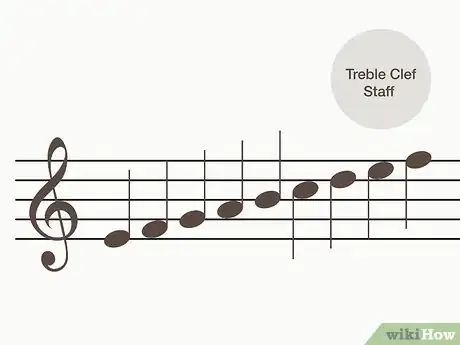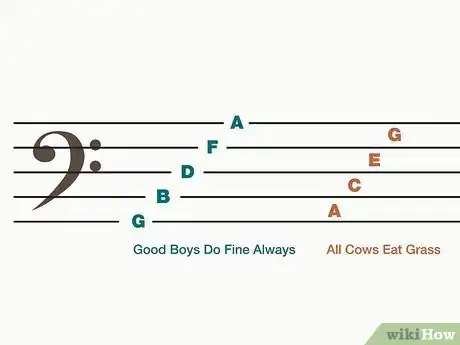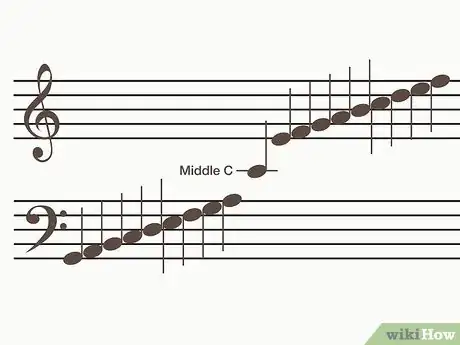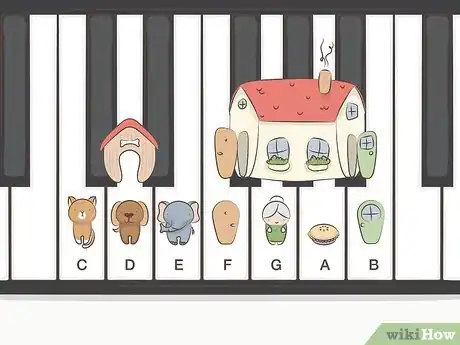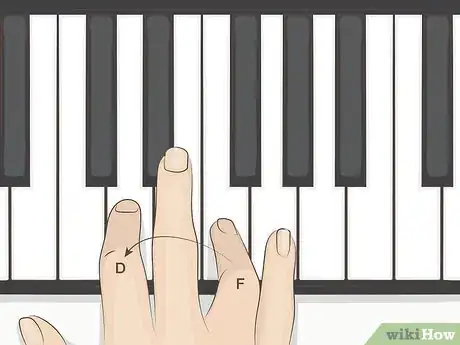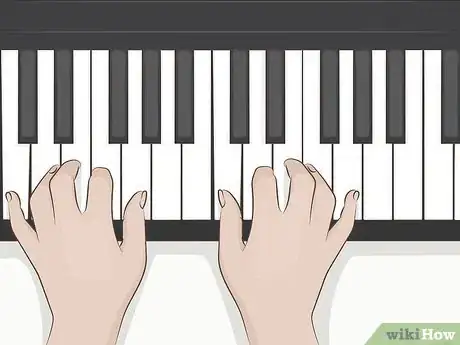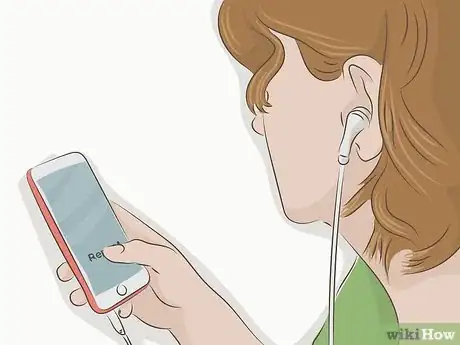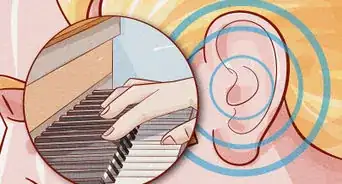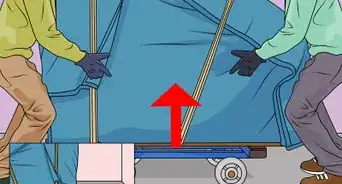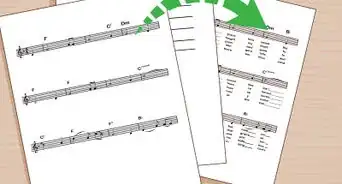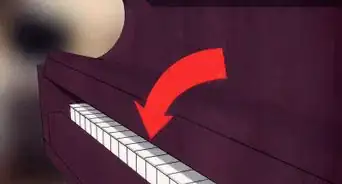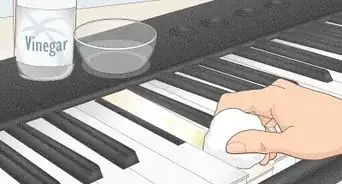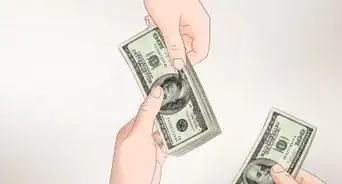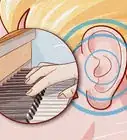This article was co-authored by Michael Noble, PhD. Michael Noble is a professional concert pianist who received his PhD in Piano Performance from the Yale School of Music. He is a previous contemporary music fellow of the Belgian American Educational Foundation and has performed at Carnegie Hall and at other venues across the United States, Europe, and Asia.
There are 12 references cited in this article, which can be found at the bottom of the page.
This article has been viewed 63,289 times.
The piano is a beautiful and versatile instrument that can be a lot of fun to learn. It may seem a little intimidating at first because of the number of keys, but anyone can learn the notes to play. One of the main ways to get started is by reading sheet music and figuring out how the notes correspond to the piano keys. Practice your hand position with a few basic scales and exercises. The sound each note makes is important, so also play to recognize notes by ear. With frequent practice, you can remember notes and start playing with more proficiency.
Steps
Learning Notes through Sheet Music
-
1Plot the notes of the treble clef staff on paper. A staff is a set of 5 lines and 4 spaces you see when you open up a music book. Each line and space represents a different note. The treble clef staff is indicated by a symbol that looks similar to an ampersand (&). After making the staff with the cleft in front, mark a single note on each line and space. Start at the bottom and work to the top while moving across the staff.[1]
- Remember that there are 7 total musical notes. They are listed by letters from A to G. Each letter corresponds to a key on the piano.
-
2Use mnemonics to remember the notes of the treble clef staff.[2] Many people studying for the first time learn how to read sheet music through clever phrases. The usual one corresponding to the staff lines, starting from the bottom, is “Every Good Boy Does Fine.” For the spaces, think of “FACE.”[3]
- For example, the lowest line corresponds to an E note. The next line is a G, and the one after that is a B.
Advertisement -
3Make a second staff for the bass clef. The bass clef staff is used to show lower-pitched notes played on the piano with your left hand. Draw an identical staff underneath the first one you made. Leave a small space between the two of them. Then, put a bass clef in front of it, which looks like a C with a pair of dots over it.[4]
- There are actually 3 notes that fall between the staves. Imagine that there is an invisible line running between the staves, keeping them separate.
-
4Write down a short phrase to memorize the notes of the bass clef staff. Learn the strings by remembering “Good Boys Do Fine Always.” For the spaces, remember “All Cows Eat Grass.” Each word corresponds to a note on the staff. By reading sheet music this way, you can begin figuring out where each note is on a piano.[5]
- The bottom line corresponds to a G note, followed by a B, D, F, and A note.
- The spaces, starting from the bottom one, are A, C, E, and G.
-
5Mark the location of middle C and other important notes. Middle C is the note that falls directly between the treble and bass staves. After the last note of the bass clef, draw a small dash between the staves. Draw a circle on the line to represent middle C. Many piano players use this note to position their hands in the middle of the keyboard and count to other notes.[6]
- Remember that there is a space between middle C and each staff. These spaces correspond to notes B and D.
- If you’re unsure of where a note is, you can choose any of the notes you know, like middle C, and count to it using the piano’s white keys. For example, B is 1 key before C, while D is 1 key after it.
- Practice by drawing a staff and labeling the notes in a random order. Alternatively, count the white keys on the piano to find different notes.
Finding Notes on the Piano Keys
-
1Locate the middle C key in the center of the piano. Middle C is typically the fourth C key from the left and is underneath the manufacturer’s logo. If you look closely at the keys, you will see a pattern of 2, then 3, black keys with 7 white keys around them. The first white key to the left of the set of 2 black keys is always a C key. By following this pattern, you can always count the sets of keys to find middle C and a good starting point while playing.[7]
- Middle C is usually played with your right hand unless you’re using it to hit notes higher on the keyboard.
-
2Determine the location of the notes through a short story. Think of the set of 2 black keys as a dog house. The dog lives in it, so the middle white key is a D. The dog lives with a cat (C) on the left and an elephant (E) on the right. Then, think of the set of 3 black keys as grandma’s house, containing the FGAB notes.[8]
- Grandma’s house has a front door (F) on the left and a back door (B) on the right. Grandma (G) is next to the front door and has baked an apple pie (A).
- Starting with the C key, the white keys are CDE and FGAB. Go over the story several times while practicing until you’re able to memorize the notes.
-
3Label the keys with stickers if you need reminders for the notes. Get some small, circular stickers that won’t get in your way while playing. Place a sticker near the bottom of each key. Then, write the corresponding note in pen. This will help you when you’re first learning since you can look down and instantly see what note you’re playing.[9]
- Combine this shortcut with the short story and other tricks until you’re able to memorize the notes. Then, remove the stickers to try playing without them.
-
4Count the keys to find any notes between ones you recognize. The white keys are labeled by letter, starting with A and ending with G. After you reach G, they start at A and repeat over and over again. Once you are able to recognize one note, such as middle C, you can count to other notes. Remember to count only the white keys, since the black keys fall between them.[10]
- For example, if you hit an F note and need to go back to a D note, you can count down to it. It will be 2 notes away.
- If you play a C note but want it in a higher pitch, count 7 white keys to the right. For a lower pitch, count 7 keys to the left.
- This is a useful trick if your piano’s keys aren’t labeled and you lose track of the notes while playing.
-
5Use the black keys to hit sharp and flat notes. The black keys fall between the white keys and produce slightly higher or lower pitches. To understand the black keys, first pick a white key. The black key on the right will be the sharp version of that note. The one on the left will be the flat version. Label these keys with stickers as well if you need to do so to memorize them while practicing.[11]
- For example, if you place your finger on a C key, the black key to the right is C-sharp. It is to the left of a D key, so it is also D-flat. They are the same note.
- The black keys repeat just like the white keys do, so you can find notes no matter where you have your hands.
Training Your Hands to Play Notes
-
1Play scales to learn where notes are located on the piano. Scales are simple series of musical notes, so they are easy to play. Start with the C major scale. The entire scale is C, D, E, F, G, A, B, C. To play it, start with one of the C keys, then hit each white key in order until you get to the next C key. You can go up or down the scale until you know exactly which key corresponds to each note.[12]
- Scales are one of the simplest but most effective exercises for learning piano notes. Whenever you’re about to play the piano, warm up with scales for 15 to 20 minutes.
- Many scales can be played with one hand. Eventually, transition to longer scales that require both your hands.
- Some other scales to try include the C major arpeggio, C minor, and C minor arpeggio scales. There are many other scales as well, and they are all made up of different notes.
-
2Play some basic songs to get started reaching for the keys. Pick out a few simple songs that don’t require a lot of speed or technique. These kinds of songs often do not use the black keys at all. They consist of a series of notes you can play by tapping the white keys. Since they are slow and uncomplicated, they provide a chance for you to get accustomed to reaching for different notes on the piano.[13]
- Some good examples of songs to start with include Twinkle Twinkle Little Star, Hot-Crossed Buns, and Mary Had A Little Lamb.
-
3Say the names of the notes out loud while playing them. This can be a helpful way to recognize what keys you’re pressing without having to glance down at your fingers every once in a while. Start with scales or some simple songs you know. Play them slowly, feeling each key and listening to their sounds while reciting each note afterward.[14]
- Another way to do this is to make a melody by hitting several different keys. Don’t play the notes in order like you would for a scale. Make something harder to remember that forces you to move your hands.
-
4Play exercises that involve using both your left and right hands. When you’re first starting out, use your right hand to hit higher notes and your left hand to hit lower ones. As you learn, gradually transition to using all of your fingers on both hands. Try playing longer scales and more complex songs that require you to move your hands along the keys.[15]
- Learning right and left-handed parts separately is easier at first. Combine them as you gain experience.
- Another option is to play the same songs and scales at a different pitch. Shift your hands to the left to hit lower notes and to the right to hit higher notes.
- When playing scales, try moving up the scale with your right hand and back down it with your left hand.
-
5Practice playing at different tempos to increase your speed. Your first attempts at playing notes by hand are most likely going to seem slow. Your speed will improve with experience. One way to help with this is by attempting to play slow songs and scales at a faster rate. Most of these songs are meant to be played at a slow tempo, so challenge yourself by moving your hands faster and faster.[16]
- Playing with speed becomes easier once you successfully memorize the notes. You may still need to check your hand positioning from time to time, but not as much as when you started.
Recognizing Notes by Ear
-
1Listen to music several times before beginning to play it. Recognizing notes is one of the most important parts of playing by ear. If you are very familiar with a piece of music, you’re going to have a much easier time finding and remembering the notes on the piano. Try to identify each note as you hear it in the recording. You may not get them all right away, but that is okay.[17]
- Search for piano recordings online. Make sure they are clear and audible so you have an easier time recognizing the notes.
- Start with simple songs while you’re still learning the notes. Move onto harder pieces when you think you know where the notes are on the piano keys.
-
2Press the piano keys to get used to the sounds they make. Match them as best you can to the song you heard. Each note should sound similar in pitch. This will be easier if you already have an idea of how a piano is arranged, but you can do it by listening closely to the sound each key makes. Try playing all of the keys one at a time to get accustomed to the different pitches.[18]
- Remember where the notes begin repeating. They begin repeating after every set of 7 white keys. The keys are used to play the same notes at higher and lower pitches.
- Look at the keys while you play to get accustomed to their positioning. Note which ones you’re touching and the sound they produce.
-
3Attempt to play the song without looking at the keys. Position your hands on the keyboard and begin playing. Match the song as best as you can. You may not perfect it at first, but keep practicing. By doing this often, you will eventually be able to identify the sound of each note and its location on the keyboard.[19]
- One way to practice is by playing various scales without looking. Then, move onto simple songs. With enough practice, you won’t even need to look down to know where the notes are.
References
- ↑ http://www.opentextbooks.org.hk/ditatopic/2189
- ↑ https://www.hellosimply.com/blog/piano-beginner/best-way-memorize-piano-notes/
- ↑ https://brenthugh.com/piano/mnemonicdevices.html
- ↑ http://www.opentextbooks.org.hk/ditatopic/2189
- ↑ https://brenthugh.com/piano/mnemonicdevices.html
- ↑ https://www.joytunes.com/blog/music-fun/best-way-memorize-piano-notes/
- ↑ https://www.pianoscales.org/fingerings.html
- ↑ https://www.bestpianotips.com/memorize-the-piano-notes/
- ↑ https://www.pianoscales.org/fingerings.html
- ↑ https://www.youtube.com/watch?v=QdIl0Q-uPY0&feature=youtu.be&t=83
- ↑ https://www.bestpianotips.com/memorize-the-piano-notes/
- ↑ https://www.pianoscales.org/major.html
- ↑ https://musicgny.com/easy-songs-to-learn-and-play-on-piano/
- ↑ https://www.joytunes.com/blog/music-fun/best-way-memorize-piano-notes/
- ↑ https://www.youtube.com/watch?v=mpIhNCO-drM&feature=youtu.be&t=44
- ↑ https://www.joytunes.com/blog/music-fun/best-way-memorize-piano-notes/
- ↑ https://www.joytunes.com/blog/learn-to-play/how-to-play-piano-by-ear/
- ↑ https://www.joytunes.com/blog/learn-to-play/how-to-play-piano-by-ear/
- ↑ https://www.joytunes.com/blog/music-fun/best-way-memorize-piano-notes/
